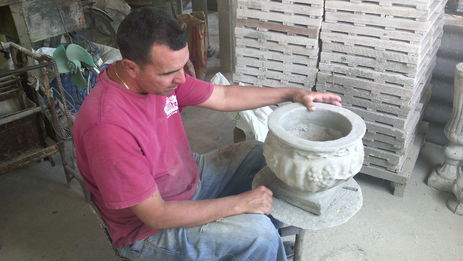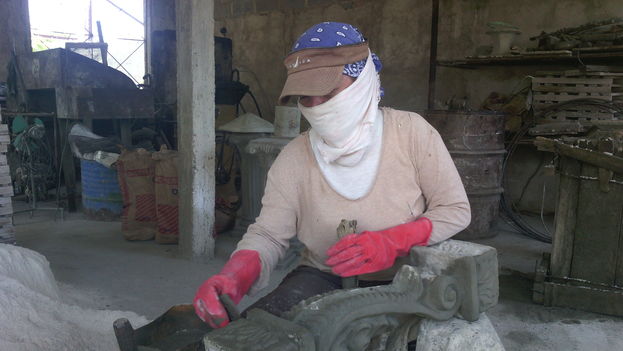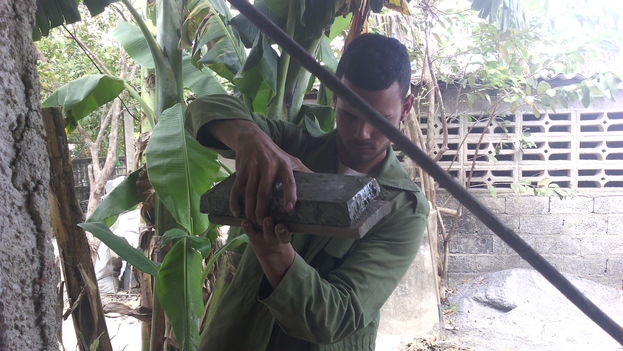
![]() 14ymedio, Ricardo Fernandez, Pinar del Rio, 14 March 2017 – They call it grey gold because it repairs damage, prevents divorce and builds houses. Cement is one of the most in-demand products in Cuba today where 39% of the housing inventory is defective or in a bad state, according to a report by the Housing authorities.
14ymedio, Ricardo Fernandez, Pinar del Rio, 14 March 2017 – They call it grey gold because it repairs damage, prevents divorce and builds houses. Cement is one of the most in-demand products in Cuba today where 39% of the housing inventory is defective or in a bad state, according to a report by the Housing authorities.
In the midst of pressing construction needs, a taste for the ornamental also is developing. A newly emerging class decorates its houses with friendly garden gnomes, pelicans with thin legs who appear at front doors and balusters in the shape of sexy women.
After a long period of block-shaped construction, made of pre-fabricated and undecorated pieces, many Cubans appear ready to make up for lost time. The “cement potters” industry, a self-employment occupation that is on the rise, has been made to bloom by the demand for façade decorations.
Victor Rodriquez lives in Pinar del Rio and considers himself an artist of concrete. His work day begins early when he gets the molds for the pieces that he assembled 12 hours earlier. His hands reveal panels, pedestal vases, mushrooms, lions, flowers, pine cones, pyramids, friezes and post corners.
The potter then moves to the stage of scraping, polishing and painting each piece with a solution of cement and water. He does it like someone who bathes and touches up a delicate baby. His small courtyard is crowded with the sculptures that will later adorn the homes of the province or some distant town.

Victor has a loyal clientele, although the competition in the area is strong, and the number of self-employed workers devoted to these activities is growing. The craftsman stands out because he designs his own pieces instead of buying ready-made molds, a detail that many appreciate in an industry that lives by imitation and the repetition of motifs.
Each day, when he finishes his work near 7 pm, Victor bathes to leave behind that grey powder that covers him from head to foot. After eating, he dedicates himself to giving form to the clay that will serve as a sample for casting the cement molds. After polishing and painting, the prototypes are ready to produce new series of figures.
“It is more work, but I never liked to be anyone’s echo,” Victor proudly explains about his originality. “I have never been able to promote my business, and I live away from the city, but the clients themselves have spread the word, and the orders even come from other municipalities,” he explains to 14ymedio.
With the growing demand, Victor’s family became involved in his efforts. His wife polishes, retouches and paints, while his son helps him prepare the concrete and cast the pieces. “It is hard work,” says the young man, who decided to become a potter with his father. “But it pays, and I like it,” he concludes.
“Getting the materials is the most difficult part because there is no wholesale market,” complains the business owner. Most times he has to order from retailers who buy it from the suppliers and bring it to the house.
“Yes, I do demand receipts from them and quality products. In order to maintain my standards I only use pp350 cement, more expensive but also more durable.” The mixture also includes “artificial sand,” he points out.
The Cuban cement industry suffered with the fall of the socialist camp. Currently, the country has six factories that produce grey gold, and in 2016 they reached 1,494,000 tons of the product, of which some 400,000 were distributed in the retail market.

However, they still do not produce “the volumes necessary to satisfy an ever-growing demand,” according to Cesar Revuelta, vice-president of the Construction Materials Group. Between 2014 and 2015, the amount of cement that the country had to import underwent a significant increase from 2,677 tonnes to 4,349.
At the end of 2015, the Mexican business Cemex, one of the leading worldwide cement producers, showed its interest in returning to the Island, whether through the sale of cement or the installation of a plant. However, the establishment of an industry on Cuban soil has still not materialized.
But not only the materials shortage can damage the work of these craftsmen. “Sometimes the sculptures are ruined because the molds are badly assembled,” explains Victor. “It has happened to me when I am stressed, that’s why I try to stay focused on the work.”
The pieces made by the Pinareño have had great reception not only because of their unique designs but also because of their quality and durability. But the business of cement ornaments also is rife with swindles and tricks.
“There are no quality controls for concrete construction materials, generally the only inspection carried out for individuals in that line of business is of a fiscal character,” explains Alexander Morejon, official with the National Office of Tax Administration (ONAT), in Pinar del Rio.
There have been cases of manufactured balusters incapable of supporting weight or pieces eroded by humidity and saltpeter. “I ordered some vases to place on the balcony but they have fallen to pieces,” says Monica, owner of a recently remodeled dwelling in San Jose de Las Lajas.
The woman believes that in her case the artisan used “a mix with sea sand, and the cement was overcome. Placing the decorations on the upper story of her house has caused problems, and “it is dangerous because pieces fall, and children play just below.”
However, Victor’s clients attest the quality of his products. “My statue-shaped balusters have been at the doorway more than seven years and look like the first day,” Angel Izquierdo, from the Brione Montoto village, tells this daily when he shows up at the potter’s home for the purchase of patio tiles, another of the products that he offers.
“I am about to finalize a machine to make floor tiles with different mosaic designs,” says Victor as he shows the pieces of a rustic press with which he hopes to increase his earnings.
Translated by Mary Lou Keel
